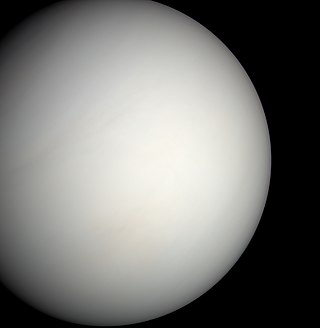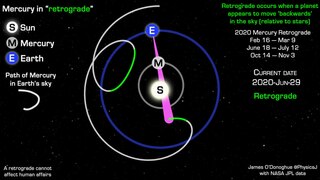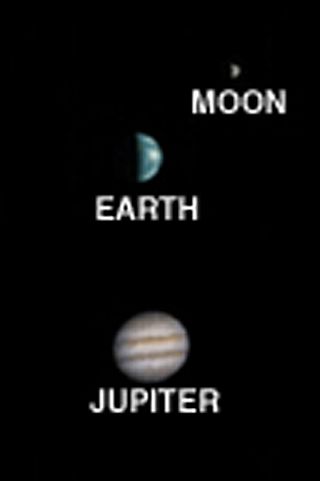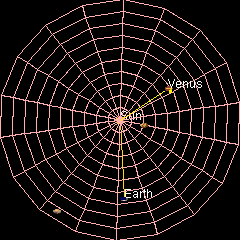
Mercury is the first planet from the Sun and the smallest in the Solar System. In English, it is named after the ancient Roman god Mercurius (Mercury), god of commerce and communication, and the messenger of the gods. Mercury is classified as a terrestrial planet, with roughly the same surface gravity as Mars. The surface of Mercury is heavily cratered, as a result of countless impact events that have accumulated over billions of years. Its largest crater, Caloris Planitia, has a diameter of 1,550 km (960 mi) and one-third the diameter of the planet. Similarly to the Earth's Moon, Mercury's surface displays an expansive rupes system generated from thrust faults and bright ray systems formed by impact event remnants.

A lunar phase or Moon phase is the apparent shape of the Moon's directly sunlit portion as viewed from the Earth. In common usage, the four major phases are the new moon, the first quarter, the full moon and the last quarter; the four minor phases are waxing crescent, waxing gibbous, waning gibbous, and waning crescent. A lunar month is the time between successive recurrences of the same phase: due to the eccentricity of the Moon's orbit, this duration is not perfectly constant but averages about 29.5 days.

Venus is the second planet from the Sun. It is a terrestrial planet and is the closest in mass and size to its orbital neighbour Earth. Venus is notable for having the densest atmosphere of the terrestrial planets, composed mostly of carbon dioxide with a thick, global sulfuric acid cloud cover. At the surface it has a mean temperature of 737 K and a pressure of 92 times that of Earth's at sea level. These extreme conditions compress carbon dioxide into a supercritical state close to Venus's surface.

Apparent retrograde motion is the apparent motion of a planet in a direction opposite to that of other bodies within its system, as observed from a particular vantage point. Direct motion or prograde motion is motion in the same direction as other bodies.

In astronomy, a conjunction occurs when two astronomical objects or spacecraft appear to be close to each other in the sky. This means they have either the same right ascension or the same ecliptic longitude, usually as observed from Earth.

A terminator or twilight zone is a moving line that divides the daylit side and the dark night side of a planetary body. The terminator is defined as the locus of points on a planet or moon where the line through the center of its parent star is tangent. An observer on the terminator of such an orbiting body with an atmosphere would experience twilight due to light scattering by particles in the gaseous layer.

In astronomy, a planet's elongation is the angular separation between the Sun and the planet, with Earth as the reference point. The greatest elongation of a given inferior planet occurs when this planet's position, in its orbital path around the Sun, is at tangent to the observer on Earth. Since an inferior planet is well within the area of Earth's orbit around the Sun, observation of its elongation should not pose that much a challenge. When a planet is at its greatest elongation, it appears farthest from the Sun as viewed from Earth, so its apparition is also best at that point.

In astronomy, a transit is the passage of a celestial body directly between a larger body and the observer. As viewed from a particular vantage point, the transiting body appears to move across the face of the larger body, covering a small portion of it.

In astronomy, an extraterrestrial sky is a view of outer space from the surface of an astronomical body other than Earth.

Many astronomical phenomena viewed from the planet Mars are the same as or similar to those seen from Earth; but some are quite different. For example, because the atmosphere of Mars does not contain an ozone layer, it is also possible to make UV observations from the surface of Mars.

Spherical astronomy, or positional astronomy, is a branch of observational astronomy used to locate astronomical objects on the celestial sphere, as seen at a particular date, time, and location on Earth. It relies on the mathematical methods of spherical trigonometry and the measurements of astrometry.

The phases of Venus are the variations of lighting seen on the planet's surface, similar to lunar phases. The first recorded observations of them are thought to have been telescopic observations by Galileo Galilei in 1610. Although the extreme crescent phase of Venus has since been observed with the naked eye, there are no indisputable historical pre-telescopic records of it being described or known.

In observational astronomy, phase angle is the angle between the light incident onto an observed object and the light reflected from the object. In the context of astronomical observations, this is usually the angle Sun-object-observer.

Paul Wittich was a German mathematician and astronomer whose Capellan geoheliocentric model, in which the inner planets Mercury and Venus orbit the Sun but the outer planets Mars, Jupiter and Saturn orbit the Earth, may have directly inspired Tycho Brahe's more radically heliocentric geoheliocentric model in which all the 5 known primary planets orbited the Sun, which in turn orbited the stationary Earth.
In astronomy, a phase curve describes the brightness of a reflecting body as a function of its phase angle. The brightness usually refers the object's absolute magnitude, which, in turn, is its apparent magnitude at a distance of one astronomical unit from the Earth and Sun.

In astronomy, a syzygy is a roughly straight-line configuration of three or more celestial bodies in a gravitational system.
This glossary of astronomy is a list of definitions of terms and concepts relevant to astronomy and cosmology, their sub-disciplines, and related fields. Astronomy is concerned with the study of celestial objects and phenomena that originate outside the atmosphere of Earth. The field of astronomy features an extensive vocabulary and a significant amount of jargon.

In positional astronomy, two astronomical objects are said to be in opposition when they are on opposite sides of the celestial sphere, as observed from a given body.

Venus has an orbit with a semi-major axis of 0.723 au, and an eccentricity of 0.007. The low eccentricity and comparatively small size of its orbit give Venus the least range in distance between perihelion and aphelion of the planets: 1.46 million km. The planet orbits the Sun once every 225 days and travels 4.54 au in doing so, giving an average orbital speed of 35 km/s (78,000 mph).

The Earth phase, Terra phase, terrestrial phase, or phase of Earth, is the shape of the directly sunlit portion of Earth as viewed from the Moon. From the Moon, the Earth phases gradually and cyclically change over the period of a synodic month, as the orbital positions of the Moon around Earth and of Earth around the Sun shift.















